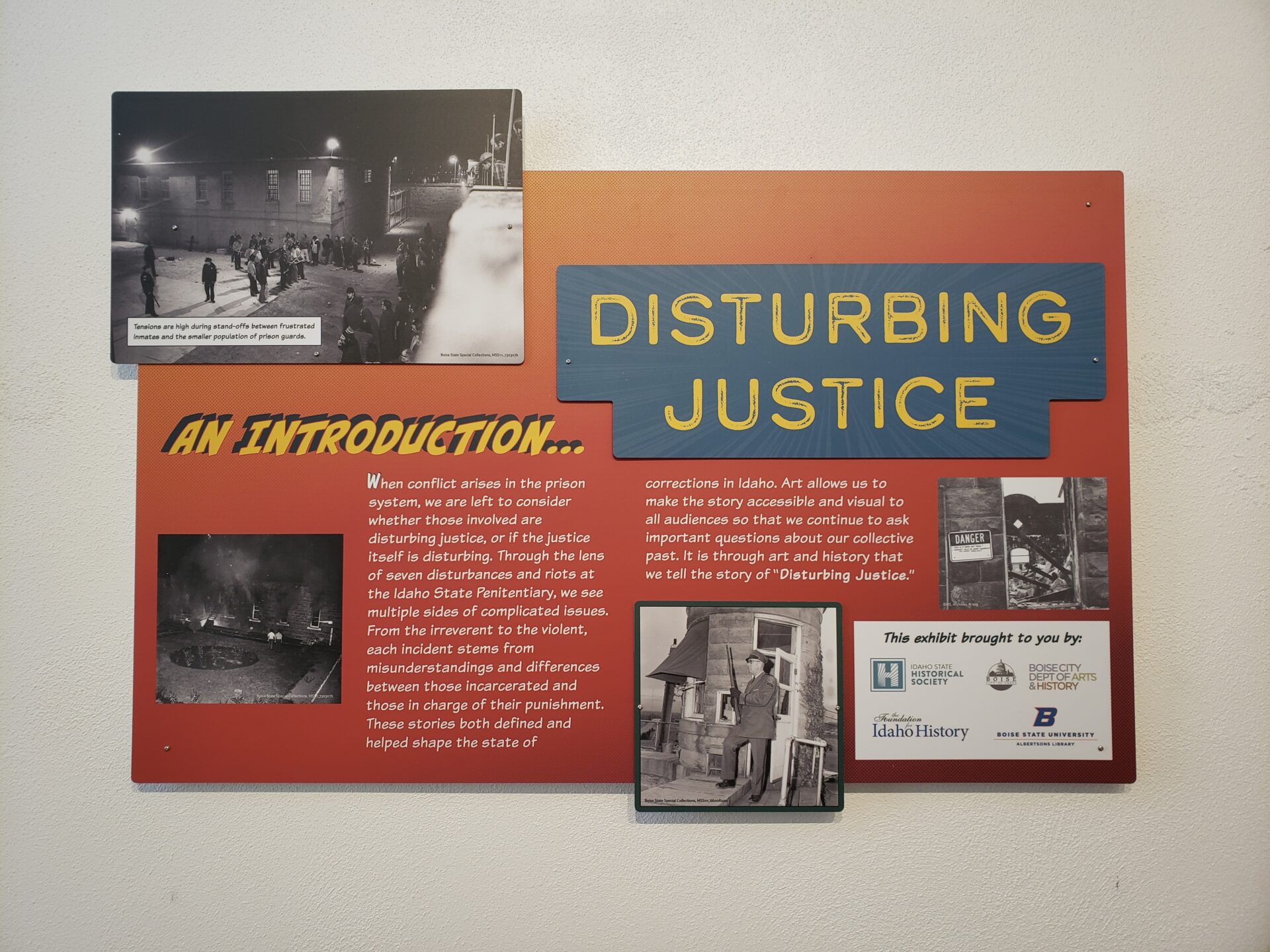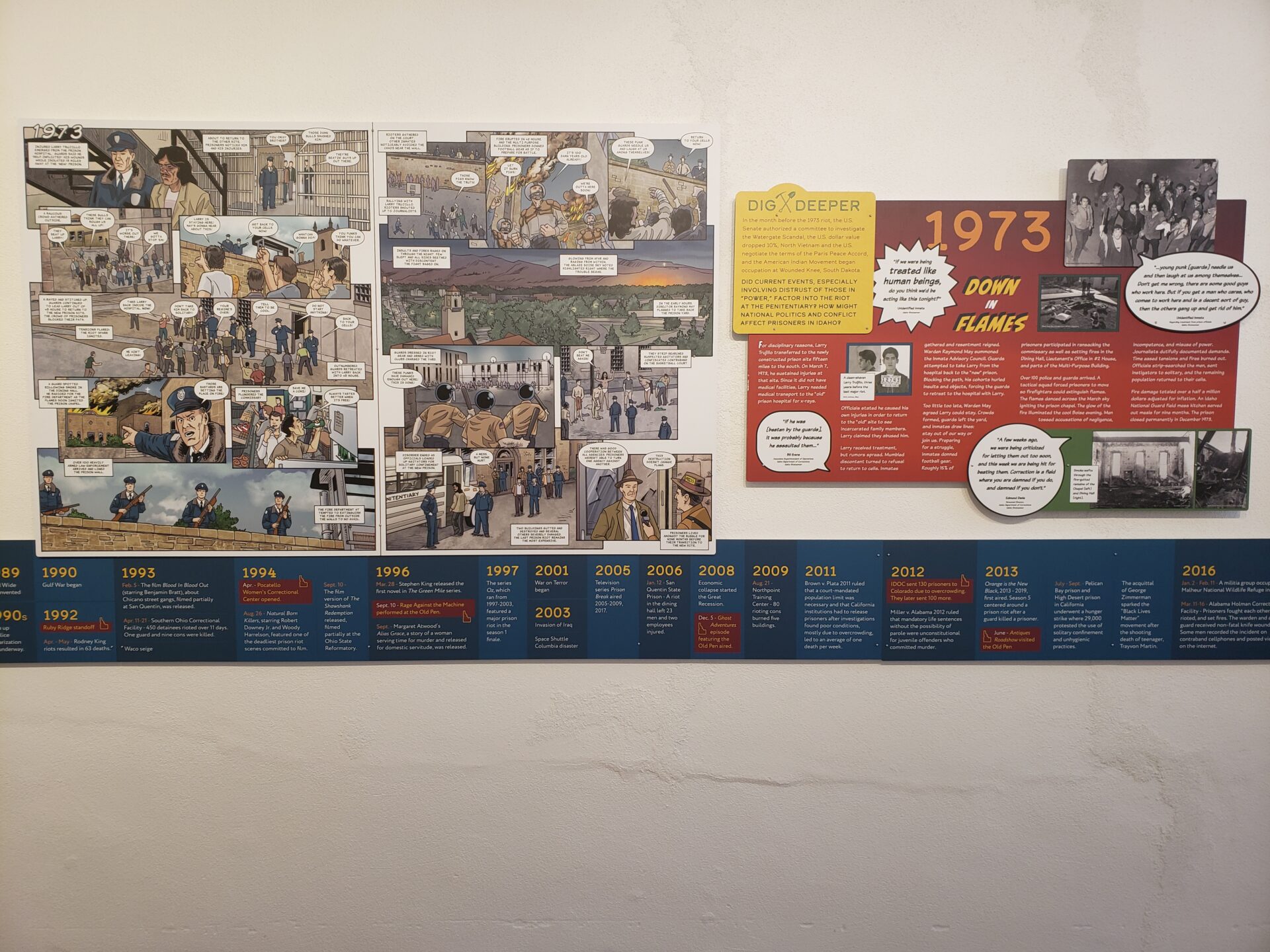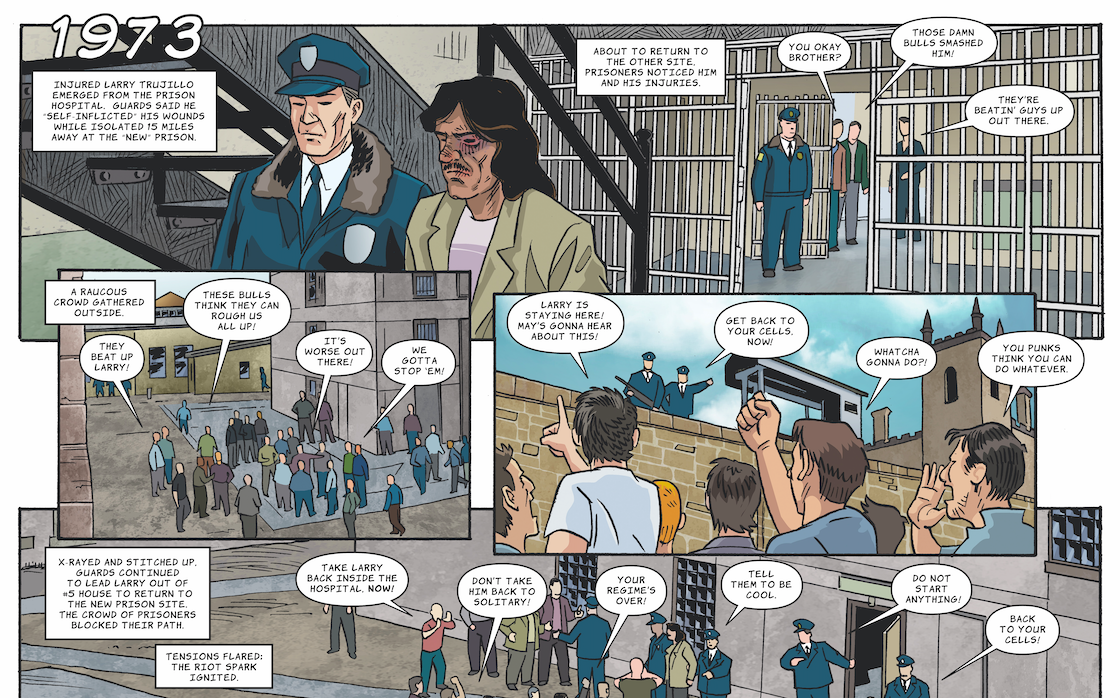Disturbing Justice: legacies of incarceration at the Old Idaho Penitentiary
24 December 2020 – Hayley Noble
The Old Idaho Penitentiary was the site of seven riots and disturbances and some of the structural damage from these actions is still evident today. For years, the exhibits and signage on display at the Old Idaho Penitentiary Historic Site never discussed the riots, so in early 2019 it was determined that the site’s latest exhibit should explain the damage still visible to visitors, contextualize the actions of prisoners and administrators, and connect historical situations in corrections to current affairs. Disturbing Justice, which opened to the public on September 25, 2020, attempts to provide a site-specific history of the Idaho State Penitentiary, while also demonstrating that the issues of prisons in Idaho, past and present, are prevalent all over the nation.

The opening exhibit panel in the “Disturbing Justice” exhibition. Photo credit: Hayley Noble
We could not predict that the launch of Disturbing Justice would coincide with increased civil unrest, discussions of racism, and calls for history to revert to “patriotic education” that glosses over difficult history. Our exhibit joins other ongoing commentaries on the problems of mass incarceration and confronts the realities of racism, particularly within the justice system. The riots that took place at the Idaho State Penitentiary in the twentieth century were mostly reactive, in response to the inhumane living conditions at the site and pushback from those in charge of the institution. Across the nation, we see that other jails and prisons experienced unrest over the same issues, particularly during the 1970s. Our hope is that those who view the exhibit come away with a better understanding of how riots happen, what the responses are, and how we can make changes within the justice system to improve the experiences of those incarcerated. In the few months that the exhibit has been open, the response has been thoughtful and largely positive. The push-back received has been by those who oppose historians using the term “social justice.”
We see Disturbing Justice as clearly related to social justice, though the mere mention of “social justice” can elicit negative reactions. Here we are defining “social justice” as discussions related to race, class, and privileges afforded to anyone who is not a cis, white male. In corrections, social justice often deals with prejudice surrounding sentencing and policing people of color and racism within the criminal justice system. This prejudice has led to our mass incarceration problem, where Black and Latino people are more likely to be incarcerated compared to any other ethnic group. See Michelle Alexander’s book The New Jim Crow to learn more.

Some of the comic book panels included in the “Disturbing Justice” exhibit. Artwork by Allen Gladfelter.
As a unique and exciting twist, we told the stories of the uprisings through comic book pages. We wanted the comics to be as accurate as possible, so there were many collaborative meetings between our staff of historians, an agency graphic designer, and the commissioned artist, Allen Gladfelter. Our team at the Old Idaho Penitentiary laid out a storyline with necessary narrations and dialogue while letting the artist craft the illustrations around our framework. Naturally, this process revealed some differences between how historians think and how artists think. Lots of meetings and discussions ensued to make sure we were all on the same page. In the end, we managed to lay out the visual stories, the important dialogue and necessary scenes, and the accompanying interpretive panels. By exhibiting the disturbances of the riot visually and through more traditional means, we were able to cater to different learning and communication styles, offering comic strips, photos, text, and deeper questions for audiences to ponder. Comic book pages and interpretation were created for each riot in the Old Idaho Penitentiary’s history.

A closer look at some of the comic art by Allen Gladfelter included in the “Disturbing Justice” exhibit. Artwork: Alan Gladfelter.
In the 1971 riot, the old prison hospital and social services building was destroyed, leaving just the building’s foundation. The exhibit is displayed adjacent to that building’s foundation. A door covered in plexiglass looks out onto the foundation as a reminder of the damage done both physically and emotionally. That slab of concrete is used to ask questions, with visitors responding in sidewalk chalk, and staff curating those responses.
When the exhibit opened, our chalk prompt read: “Describe in three words or a picture what justice means to you.” COVID-19 restrictions have prevented any implementation of other interactive elements that were originally planned. Additionally, the exhibit space is very small, so staff is monitoring the building to ensure social distancing. The site also has other restrictions in place, requiring face masks, limiting attendance to 50 people per hour, and not offering guided tours. We are currently developing resource packets that teachers can access online, providing PDF copies of panels, discussion question ideas, and tools to help define what riots, protests, and demonstrations are. Additionally, the Old Idaho Penitentiary’s podcast, Behind Gray Walls, which was reviewed in the November 2020 issue of The Public Historian, covers the history of the riots and the exhibit throughout its fourth season. You can hear from the Old Penitentiary staff and the exhibit artist in the introductory episode. The combination of exhibit, education packet, and podcast season has culminated in an important addition to the Old Idaho Penitentiary that explores the site’s troubled past as well as ongoing problems affecting corrections, demonstrating why history remains so vital and relevant to understanding the present.

A chalk drawing of Ruth Bader Ginsburg drawn outside the Old Idaho Penitentiary by a visitor. Photo credit: Hayley Noble.
~Hayley Noble works as a researcher at the Old Idaho Penitentiary Historic Site, which is part of the Idaho State Historical Society. She holds a master’s degree in public history from Boise State University.



